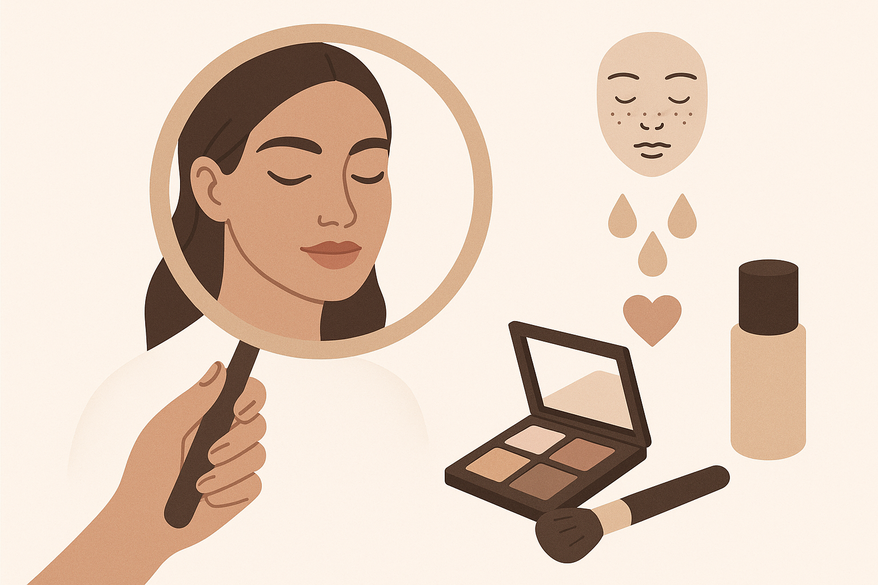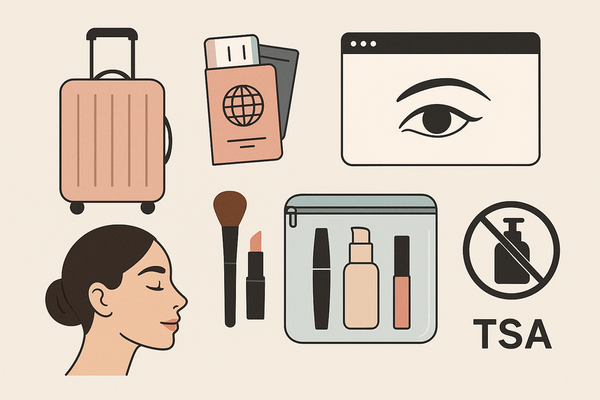The Ultimate Guide to Personalized Makeup Style Tips
Discover personalized makeup style tips tailored to your features, skin type, and personal taste for a routine that enhances your natural beauty.

Estimated reading time: 12 minutes
Key Takeaways
- Customization is key: Personalized makeup highlights your unique features and undertones.
- Feature assessment: Identifying face shape, skin type, and eye characteristics ensures the right techniques.
- Routine development: A bespoke step-by-step plan—from prep to finishing touches—boosts confidence and longevity.
- Tools & products: Investing in tailored brushes, formulas, and testing protocols prevents mismatches and irritation.
- Experiment & adapt: Controlled trials, seasonal swaps, and progress tracking refine your look over time.
Table of Contents
- Section 1: Understanding the Basics of Personalized Makeup Style Tips
- Section 2: Assessing Personal Features for Personalized Makeup Style Tips
- Section 3: Developing a Personalized Makeup Routine with Personalized Makeup Style Tips
- Section 4: Tools and Products Tailored for You and Personalized Makeup Style Tips
- Section 5: Experimentation and Adaptation with Personalized Makeup Style Tips
- Conclusion
- FAQ
Section 1: Understanding the Basics of Personalized Makeup Style Tips
Makeup personalization goes beyond copying trends. It’s about creating a bespoke beauty plan that solves your specific needs. Trends offer inspiration, but personalization delivers results.
Key distinctions:
- Personalization = Solutions for individual needs and characteristics
- Trends = One-size-fits-all looks that may not suit everyone
- Face Shape
- Oval, round, square, heart, diamond
- Impacts contouring and highlight placement
- Round faces benefit from shading at temples and jawline; heart shapes need chin contouring
- Skin Type
- Dry, oily, combination, sensitive
- Formula selection: hydrating vs. matte
- Dry skin: look for dewy, moisture-rich bases
- Oily skin: choose oil-absorbing, long-wear mattes
- Eye Color & Features
- Complementary shadow choices:
- Blue eyes: warm browns, copper, peach
- Green eyes: mauve, plum, rose gold
- Brown eyes: deep neutrals, emerald green, navy
- Individual features like hooded lids or deep-set eyes dictate placement
- Complementary shadow choices:
Section 2: Assessing Personal Features for Personalized Makeup Style Tips
To master bespoke beauty, start by evaluating your features in three steps:
A. Identify Your Face Shape
- Measure: forehead width, cheekbone width, jawline width, face length
- Compare:
- Oval: balanced dimensions
- Round: width ≈ length
- Square: strong jawline, angular hairline
- Heart: wider forehead, narrow chin
- Diamond: narrow forehead, wide cheekbones
- Contour under cheekbones for round faces
- Highlight center of forehead and chin for diamond shapes
B. Determine the Right Foundation, Concealer & Blush for Your Skin Type
- Oily Skin: oil-absorbing powders, long-wear matte liquids
- Dry Skin: hydrating, dewy-finish creams
- Combination: balance shine-control and hydration where needed
- Testing Protocol:
- Swatch foundation/concealer on jawline under natural light
- Blend and check for seamless match
- Note formula feel—lightweight vs. full-coverage
C. Select Colors to Complement Natural Undertones
- Vein Test:
- Cool undertones = blue/purple veins
- Warm undertones = green/yellow veins
- Neutral = mix of both
- Warm undertones: peach, terra-cotta, warm coral
- Cool undertones: rose, plum, berry
- Neutral undertones: soft rose, mauve, dusty pink
How to Use a Skin Tone Analyzer for Perfect Foundation Matching
For a seamless blend of expert insight and AI-driven advice, Makeup Check AI offers personalized recommendations based on your unique features and preferences.
Section 3: Developing a Personalized Makeup Routine with Personalized Makeup Style Tips
Creating a bespoke routine involves five core steps:
- Assess Daily Needs & Lifestyle
- Quick 10-minute looks vs. long-lasting, photo-ready finishes
- Consider environment: indoor lighting, humidity, workplace dress code
- Time constraints: streamlined vs. full glam
- Prepping the Canvas
- Cleanse: gel, foam, or cream cleansers based on skin type
- Moisturize: oil-free gels for oily skin; rich creams for dry skin
- Prime:
- Pore-filling primers for large pores
- Illuminating primers for dull skin
- Mattifying primers for oily zones
- Base Application
- Foundation & Concealer:
- Match undertone and opacity needs
- Build coverage in thin layers—tackle redness or dark circles precisely
- Setting:
- Translucent powder in T-zone for combination/oily skin
- Light dusting on cheeks only for dry skin
- Techniques: buff brush for powder; damp sponge for cream/liquid
- Foundation & Concealer:
- Color Placement
- Eyes:
- Pick 2–3 shades that echo your eye color and undertone
- Blend a mid-tone in the crease; deeper shade on the outer “V”; highlight on the brow bone and inner corner
- Cheeks:
- Blush placement: apples of cheeks for round faces, higher on cheekbones for heart shapes
- Contour: hollow of the cheeks for square faces, jawline for shorter faces
- Lips:
- Low-key days: tinted balm or sheer lipstick
- Special events: layer liner, full-pigment lipstick, gloss center for dimension
- Eyes:
- Finishing Touches & Setting Spray
- Lips: use lip primer or balm base
- Brows: fill with powder or pencil following natural arch
- Lashes: curl and apply mascara or individual/cluster lashes
- Setting Spray: hydrating mist for normal/dry; mattifying spray for oily skin
Section 4: Tools and Products Tailored for You and Personalized Makeup Style Tips
Selecting the right tools and formulas amplifies your custom routine:
Choosing Brushes & Applicators
- Dense synthetic brushes for liquids and creams—deliver full coverage
- Fluffy natural-hair brushes for powders—create soft blends
- Sponge vs. brush for foundation:
- Sponge (damp): sheer to medium coverage, blurs texture
- Brush (dense): buildable coverage, more control
Product Recommendations
- Inclusive brands offering wide shade ranges and custom-blend services
- Custom-blend formulas perfect for hard-to-match tones
- Example: on-demand foundation mixing machines at select retailers
- Benefit: precise color match, optimized formula for skin concerns
Testing for Compatibility
- Patch Test: apply new product to inner wrist or behind ear; wait 24 hours for irritation
- Wear Test:
- Monitor oil breakdown, creasing, and fade over 6–8 hours
- Note changes in finish—from matte to dewy or patchy wear
Section 5: Experimentation and Adaptation with Personalized Makeup Style Tips
A true bespoke approach evolves through trial and feedback:
- Controlled Experimentation
- Start Small: swap one element—bold eyeliner, metallic shadow, or new finish
- Evaluate:
- Comfort level—does it feel heavy or light?
- Wear performance—any creasing or fading?
- Seasonal Accents
- Spring: pastels, coral blush, light finishes
- Summer: bronzed skin, waterproof formulas, vibrant lips
- Fall: warm terracottas, deep browns, matte textures
- Winter: jewel tones, creamy highlighters, rich lipsticks
- Leverage Tutorials & Expert Advice
Follow reputable artists and bespoke beauty experts. Adapt steps to your personal features—no two routines are identical (benefits of personalized aesthetics treatment). - Track Your Progress
Keep a makeup journal or photo diary. Note what works: product names, techniques, environmental factors. Refine: remove items that underperform, amplify successful combos.
Conclusion
Customized techniques are key to enhancing natural beauty, building confidence, and achieving consistent satisfaction. By assessing your features, selecting the right tools and products, and evolving through experimentation, you’ll master your own personalized makeup style tips. Embrace your individuality, refine your routine as you learn, and share your discoveries—your journey could inspire someone else’s path to bespoke beauty.
FAQ
- What is personalized makeup styling?
Personalized makeup styling is the process of tailoring products and techniques to your unique facial features, skin type, and lifestyle to achieve the most flattering and comfortable look. - How do I determine my skin undertone?
Perform a vein test by looking at veins under natural light: blue/purple indicates cool undertones, green/yellow indicates warm, and a mix suggests neutral. - How often should I update my makeup routine?
Adapt your routine seasonally or whenever your skin’s needs change—typically every 3–6 months with new products or shifts in weather. - Can AI really help with personalization?
Yes. Tools like Makeup Check AI analyze your features and preferences to recommend the best shades and formulas for you. - What if a product causes irritation?
Always patch-test new products on your inner wrist or behind the ear. If irritation occurs, discontinue use and consult a dermatologist if needed.




